 |
Brookline Ave, December 1916
Looking south from Pearl St., House on Washington St. is visible in the far distance. Looking from left to right down Brookline Ave.: #101 , a vacant lot fronted by billboards, #77, 75, 71, 65, 59, 55, a vacant lot fronted by billboards, 43, 41, continued to Washington St.
[Source: Olmsted]
|
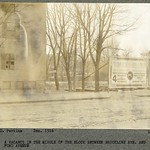 |
101 Brookline Ave. and Vacant Lots, December 1916
Just south of the entrance to Pearl St.
[Source: Olmsted]
|
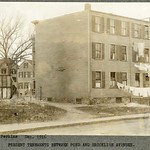 |
Rear of 55 & 59 Brookline Ave, December 1916
No longer standing
[Source: Olmsted]
|
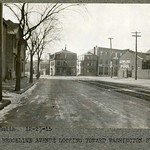 |
Brookline Ave. at Washington St.
#7 and #17 at the left. Boston Consolidated Gas Company at the right. Visible center left is 40 Washington St. at the corner of Walter Ave., one of several buildings owned by Thomas Miskell. Walter Ave. no longer exists and was located at the present day entrance to the Brook House complex. At center right is a brick building owned by John Fleming. This account of later plans for the building appeared in the 1921 issue of Automobile Topics.BROOKLINE TO HAVE GARAGE FOR WOMEN
John F Fleming Plans for Garage That Will Be Managed Operated and Patronized by Women Comfort and Convenience of Patrons Considered
Brookline Mass is to have a garage that will be managed operated and patronized by the fairer sex. Disregarding a certain traditional feminine ineptitude for filings mechanical John F Fleming of Brookline is firmly convinced that the rapidly growing number of women drivers calls for a garage run exclusively by women. In other words not only will all the patrons be women but the establishment will be managed by a woman and there will be women attendants and mechanics throughout even the cab service to be operated in connection with the garage and for its women customers will have women drivers exclusively.
For the woman owner whose only interest in her car is to have it always ready for driving the garage will offer complete service. All she needs to do when she desires to use the car is to telephone the garage. A cab will be sent to her residence for her and when she reaches the garage her car will be ready to drive away. Upon retuming she will leave the car at the garage door and if she wishes have a cab take her home. In the interval between drives the car will be whipped into driving state and will be stored in a private stall.
On the other hand for the woman who likes to take care of her car the garage will offer exceptional attractions. There will be no men about the building so the mechanically bent lady can don overalls and crawl under the car or do any work on it she pleases. There will of course be trained women mechanics to assist her in anything mechanical she does not care to tackle alone.
During the Summer months Fleming plans to fit out the building which is located at 5O Washington street with the most up to date garage equipment and to put into operation a number of original ideas he has for the comfort and convenience of feminine motorists. When it is finished the garage will have the appearance of an automobile club for women with every facility for careful handling of cars and for their maintenance in first class condition. The front of the building will be fitted up as a lounge or waiting room. There will be comfortable chairs and tables desks and also an attractive fireplace.
The garage will accommodate not more than forty cars for it is the intention to allow plenty of space in each stall and no car will be put in front of another so that owners can work around their cars or get into and get out of them without being crowded by other cars. There is a large automobile elevator connecting all floors and there will be telephones all over building connecting with an outside switchboard in the office. On the exterior of building there are to be no signs except those denoting the entrance and exit.
It is Fleming's plan to close the garage fairly early in the evening Patrons who have their cars out late can leave them at his large general garage across the street and they will be taken to their places in the women's garage and cared for early in the morning.
[Source: Olmsted]
|
 |
Start of Brookline Ave, December 1916
Looking north. Boston border on Washington St. to the right.
[Source: Olmsted]
|
 |
Start of Brookline Ave, December 1916
Looking north from NW corner of Washington St.
[Source: Olmsted]
|
 |
Lower Washington St., December 1916
Looking west toward Brookline Village from the Boston border. Middle, left: Pond Ave. entrance in front of the Gold Medal Flour billboard. Middle, right: two houses on Park Dr. facing Riverway Park.
[Source: Olmsted]
|
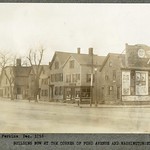 |
Lower Washington St., #1-#27, December 1916
Standing at the corner of Pond Ave. looking west toward Brookline Village
[Source: Olmsted]
|
 |
Lower Washington St.,Looking East to the Boston Border, December 1916
Brookline Ave. entering mid-left.
[Source: Olmsted]
|
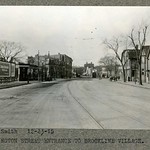 |
Lower Washington St., Looking West from the Boston Border, December 1915
Foreground left, left to right: entrances to Pond Ave., Villa Lane, Walter Ave., the begining of today's Brook House expanse. Foreground right, right to left: houses from #5 - 27 Washington St. followed by th entrance of Brookline Ave.
[Source: Olmsted]
|
 |
Pond Ave.
Leverett Pond. Rear, right to left: Washington St. goes from the Boston border over the visible stone bridge toward Brookline Village. Left: 7 houses along Pond Ave bisected by Morss Ave., all replaced by the Brook House apartments.
[Source: Smithsonian]
|
 |
114-98 Brook St., March 1, 1921
All buildings still standing except McDonnell's. Martin F. McDonnell had the grocery store at 110 Brook St. from 1904 - 1921.
[Source: Olmsted]
|
 |
Brookline Village
Looking northeast from Washington St. Foreground left: the curve of Prospect St. preceding the First Presbyterian Church, built in 1897, no longer standing. Rear, left: The large brick apartment building at 152-158 Harvard St., built circa 1900. Rear, left of center: The steeple of the Harvard Congregational Church with the cupola of the Pierce Buiding in Coolidge Corner just visible to its immediate left. Center: white apartment buildings sandwiched between Aspinwall Ave. and Homer St. Foreground, right: St. Mary's of the Assumption Church. The steeple is on Harvard St.
[Source: Digital Commonwealth]
|
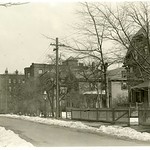 |
Davis Ave., Looking East, March, 1921
30 Davis Ave., foreground right, and distant brick apartment buildings are still standing.
[Source: Olmsted]
|
 |
86 Greenough St., November 1915
Looking northeast. Formerly an extension of Gorham Ave.
[Source: Olmsted]
|
 |
Harris St., November 1915
#17 and #11 on the left, still standing.
[Source: Olmsted]
|
 |
121 Carlton St. "Pittman Place"
Corner of Euston St. (on the left). Brick siding was later added.
[Source: Smithsonian]
|
 |
122 Carlton St.
[Source: Smithsonian]
|
 |
Boylston St. at Cypress St, December, 1915
Looking from Cypress St. north across Boylston St. At 133 Cypress St. is the Hotel Madris. Underneath the hotel on the far left at 361 Boylston St. Is the grocery store of Lucius N. Danforth who was forced to move his newly-acquired store in the Village when the building was knocked down for the widening of Harvard St. in 1905.
[Source: Olmsted]
|
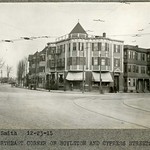 |
Northeast Corner of Boylston St. & Cypress Ave., December, 1915
Looking north on Cypress St. from Boylston. The building, partially visible, at 353-359 Boylston St. still stands. Otherwise, only the one-story building, barely visible in the distance at 122 Cypress St., still stands. On the corner is Bentley Bros. Grocers at 351 Boylston St. On the right is the apartment building at 343/345 Boylston St.
[Source: Olmsted]
|